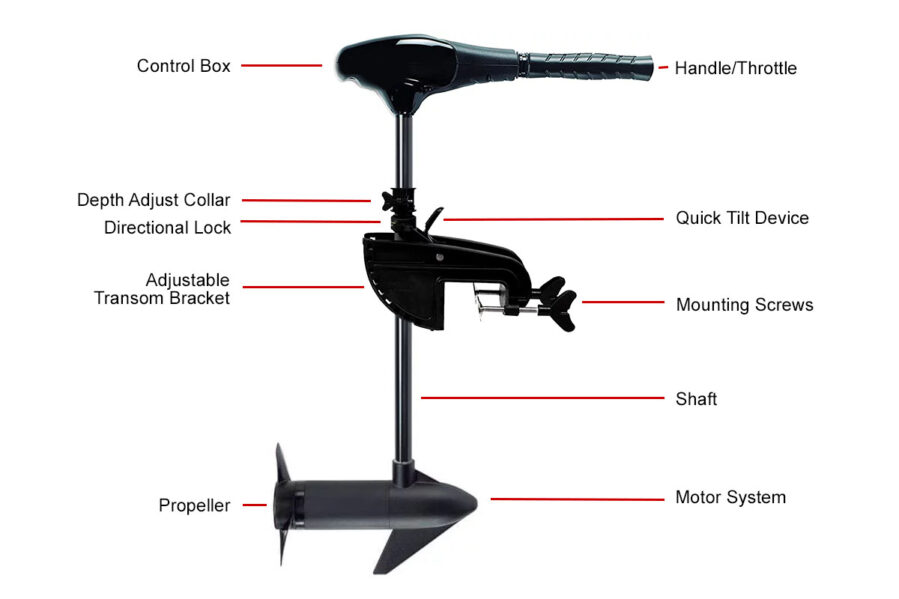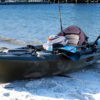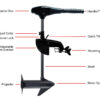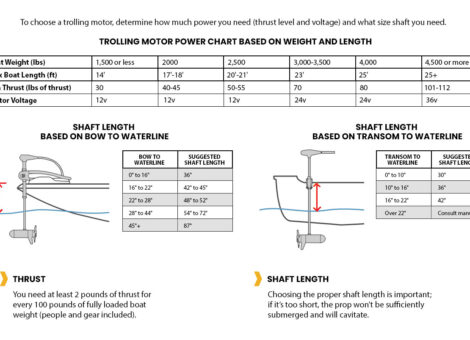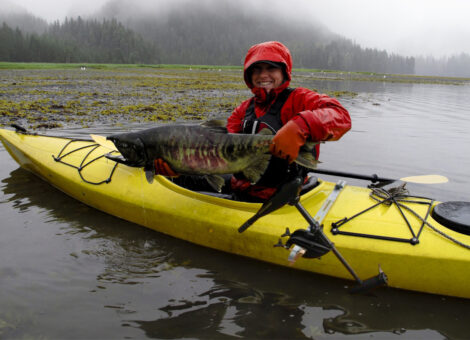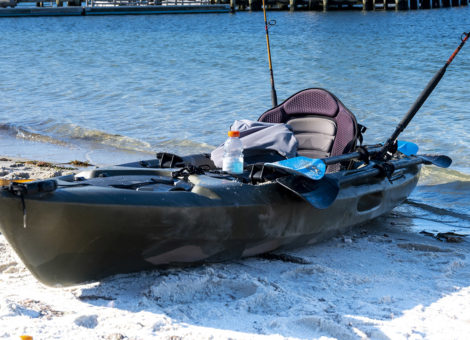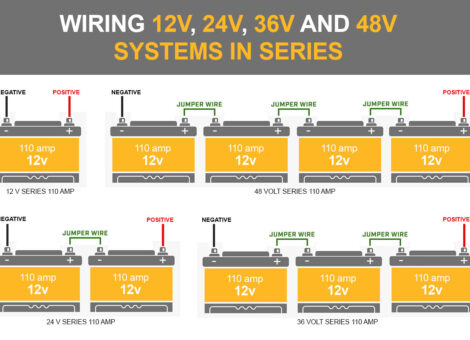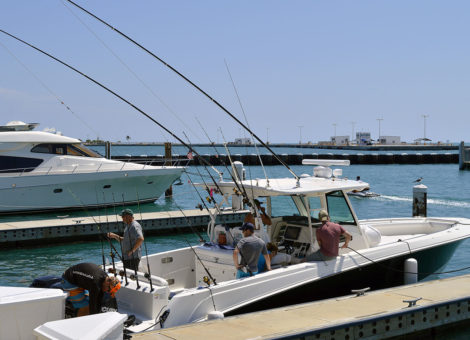This guide is designed to help you select the right trolling motor for your boat. When choosing a trolling motor you want to consider the following.
If you’re looking for a trolling motor for a smaller fishing vessel, such as a kayak, we recommend reviewing our adapted kayak trolling motors selection guide.
1. Freshwater vs Saltwater
The salinity in saltwater is harsher on motors than freshwater environments. Trolling motors used primarily in saltwater will corrode at a faster rate if not properly cleaned and maintained after each use.
To improve long-term performance and life span, it’s recommended to purchase a saltwater trolling motor if primary usage will be for saltwater. It’s not advisable to use freshwater trolling motors in saltwater, but saltwater motors can used in freshwater.
Saltwater trolling motors cost more than comparable freshwater motors because they are manufactured with higher quality, corrosion resistant parts and materials. In the long run, a saltwater trolling motor will last longer, and cost less to maintain, when used in saltwater.
2. Mount Type
There are three general types of trolling motors: bow, transom and engine mount. Each motor type has benefits and drawbacks. There are also a few specialized mount types for smaller vessels such as kayaks. These include side mounts and drive pod mounts.
Bow Mount
Bow mount are the most common type of trolling motors used by anglers. They’re ideal for medium to large boats. When compared to transom and engine mount trolling motors, bow mount motors provide significantly better control and maneuverability. Where transom and engine mount trolling motors push from behind, bow mount motors pull the from the front of boat. If maximum maneuverability is your primary objective, your best option is a bow mount. Bow mount motors also provide a wider array of control options and features.
Bow mount trolling motors are more expensive and more challenging to install. They take up more deck space than either transom or engine mount motors. Bow mount motors can only be installed on a flat deck with sufficient space on the bow.
Transom Mount
Transom mount motors are typically used on smaller fishing boats. They are easier to install and less expensive. Transom mount motors attach to the boat’s stern using a simple clamp. They take up less desk space than a bow mount motor and are easy to operate from the back of the boat. Transom mount motors are often used on small row boats, zodiacs, canoes and kayaks.
Engine Mount
Engine mount motors are less common than bow mount or transom mount motors. They are mounted on the cavitation plat on outboard motors. Engine mounts are steered via the outboard motor and motor thrust is controlled by a remote wired to the mount.
Engine mount motors are used for multi-purpose boats. They take up less space than bow or transom mount motors. Since engine mount trolling motors are attached directly to the outboard motor, they come out of the water when outboard motor is raised and when the boat planes.
Compared to bow and transom mount motors, engine mount motors are harder to control. They’re also more expensive.
Side Mount
A side mount is a setup for hooking a trolling motor to the side of a boat. In most cases, a side mount is used to retrofit a trolling motor to a smaller vessel—such as a kayak—that was not orinally designed to hold a trolling motor. The selection of side mounts is as diverse as the trolling motors they support.
Side mounts are particularly popular for kayaks. There are a variety of side mount options available on the market. Side mounts are tyically used for mounting “transom mount” style trolling motors to fishing kayaks. You can find a number of side mount designs available at larger boating stores, but there isn’t a standard setup. You’ll also find a large variety of side mounts for kayaks online that are manufactured by specialty shops, machinists, and enthusiasts of the sport.
The side mount is popular among kayakers because it positions the trolling motor near the seat allowing for high accessibility and greater control.
Drive Pod Mount
This is a mounting systems used almost exclusively for kayaks. Drive pod mounts position the trolling motor right in the drive pod where the motor is centrally positioned and easily accessible. Drive pod mounted trolling motors provide excellent maneuverability are are very convenient—but they can be a little bit more difficult to install. One of the biggest drawbacks of using a drive pod mounted trolling motor is that it isn’t retractable. This can make it easy to bottom out in the shallows and limits your ability to access certain habitats and terrains.
3. Thrust
Trolling motor power output is measured in pounds of thrust. Boat weight and size are used to determined recommended thrust. Boat weight (including load) is the most important factor for determining thrust. As a rule of thumb, you need 2 pounds of thrust for every 100 pounds of boat. Thus, a 1500 pound boat has a minimum 30 pound thrust requirement (e.g. 1500/100*2=30lbs of thrust).
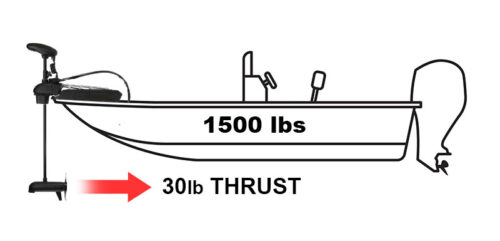
Use the following table to determine minimum thrust requirement based on boat size and weight.
| Boat Weight | Max Boat Length (ft) | Min Thrust Level (lb of thrust) |
|---|---|---|
| 1,500 or less | 14' | 30 |
| 2000 | 17'-18' | 40-45 |
| 2,500 | 20'-21' | 50-55 |
| 3,000-3,500 | 23' | 70 |
| 4,000 | 25' | 80 |
| 4,500 or more | 25'+ | 101-112 |
If wind, waves or current impact water conditions where you fish, you’ll want just a bit more thrust. For smooth calm water you should be fine at minimum thrust levels.
Also consider hull design when calculating required minimum thrust. A Deep V hull that produces drag when turning will require a trolling motor with more thrust than a trolling motor attached to a flat bottom Jon Boat. While a Pontoon Boat has a shallow draft that produces little drag, even a mild breeze will push these boats across the water.
If maintaining a fixed position in a pontoon boat, or a boat with a Deep-v hull is important, you’ll want a trolling motor with thrust that exceeds the minimum thrust requirements outlined in the above table.
4. Battery Power
Trolling motors come in 12V, 24V and 36V options. The higher the voltage, the greater the thrust provided. The larger and heavier your boat, the more thrust and voltage required for your trolling motor. General thrust-to-voltage recommendations are 12v up to 55 pounds of thrust; 24v up to 80 pounds of thrust; and 36v up to 115 pounds of thrust.
Use the following chart to determine the number of batteries needed to meet minimum thrust requirements.
| Min Thrust Level (lb of thrust) | # Batteries (voltage) |
|---|---|
| 30 | 1 (12v) |
| 40-45 | 1 (12v) |
| 50-55 | 1 (12v) |
| 70 | 2 (12v+12v=24v) |
| 80 | 2 (12v+12v=24v) |
| 101-112 | 3 (12v+12v+12v=36v) |
Run time is also an important consideration when determining battery requirements. An 80 pound thrust motor that uses two 12v batteries (24v) will provide more run time than a 55 pound thrust motor that uses just one 12v battery. Even if you only need 55 pounds of thrust, the additional voltage that comes from using a motor with 80 pounds of thrust that has two 12v batteries may be worth the investment, if you want to be able to stay on the water longer.
When attaching a 12v trolling motor to a smaller vessel, such as a Jon boat or kayak, you can increase power (thrust) by wiring a second 12v battery to the motor in series, without using a larger motor. Wiring in series allows you increase voltage, thrust and power. If you want to increase your running time from say 6 to 8 hours to 12 to 14 hours, but don’t need more power, you can wire a second 12v battery to your motor in parallel. Wiring in parallel allows you to increase capacity (amp-hours), and extend your running time, without increasing power.
5. Shaft Length
Shaft length on a trolling motor is measured from the base of the motor head to the top of the propeller housing, as shown below.
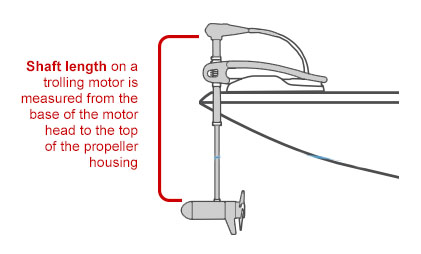
Selecting the correct shaft length is a critical aspect of choosing a trolling motor. If the shaft is too short, the motor prop won’t remain fully submerged. Too long and you won’t achieve the proper thrust and control. As a general rule, a trolling motor shaft should be long enough to maintain the center of the motor submerged at least 12″ to prevent cavitation.
Bow mount and transom mount motors have different shaft length requirements.
Bow Mount Shaft Length
Determining the proper shaft length for bow mount motors is more critical and challenging. The distance from the bow—where the trolling motor is mounted—to the water can vary dramatically from boat to boat. Additionally, a boat’s bow tends to move up and down on the water more than the boat’s transom.
The first step in determining shaft length for a bow mount motor is to measure the distance from the bow to the water line. Then add 20″ inches to this measurement, or 22″ to be safe. The sum of these two numbers will provide you the minimum recommended shaft length for your bow mount motor. It’s that simple.
The following table provides minimum shaft length for bow-mount trolling motors based on bow to waterline measurement.
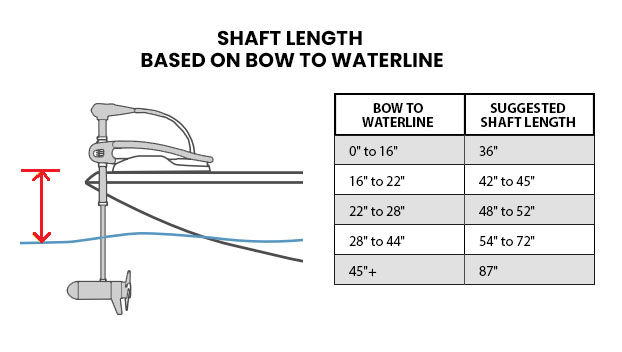
If you frequently fish offshore, or in rough, choppy waters, add 25″-27″ to your bow to water line measurement—instead of 22″. If you plan on using a hand operated bow mount motor while standing, add 12″ to the minimum recommended shaft length from the above table.
Transom Mount Shaft Length
Determining proper shaft length for transom mount motors is easier and less critical than for bow mount motors. First, measure from the mounting surface for your transom motor to the waterline. Now add 20″ (or 22″) to the measurement to determine recommended minimum shaft length.
The following table provides the minimum recommended shaft length for transom mount motors based on transom to waterline measurement.
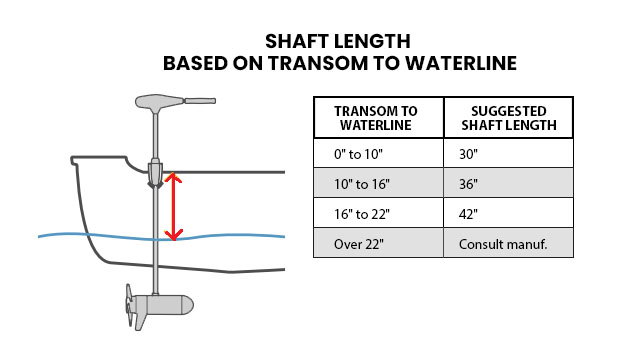
If you’re not exactly sure what shaft length you need, it’s better to go long. You can adjust a shaft that is a little too long upward using the depth collar. If you’re shaft ends up being too short, you can’t adjust it downward to make it longer.
5. Features
Many trolling motors now come with advanced features and options that greatly impact their ease of use and function. The following are the main features and options to consider—and look for—when selecting a trolling motor.
Hand vs Foot Control
If purchasing a bow mount motor, one of the biggest decisions is whether to select hand or foot controls. Each option has advantages and disadvantages. The option that will work best for you really depends on which you’ll find more convenient and comfortable based on your setup.
| Type | Advantages | Disadvantages |
|---|---|---|
| Hand Control |
|
|
| Foot Control |
|
|
There is no best options when it comes to hand versus foot controls for your trolling motor. I prefer the foot control mostly because it allows me to maintain my hands on my rod. But, if you do your research, you’ll find that opinions vary greatly and anglers swear by one or the other.
Which option you prefer is really a function of your fishing style and what type of water you’ll be fishing. If you’re standing a lot when casting, and want to keep your hands on the rod, you’ll likely prefer a foot control. If you’re a saltwater angler and need to maintain a straight line, hand controls are ideal.
Battery Gauge
This is a big one in my book. Newer trolling motor models can have the battery gauge built into the motor head. This allows you to quickly check battery charge and estimate how much time you have left before your motor goes out, or when to recharge your batteries.
Digital Displays
Many high-end trolling motor models now come standard with digital displays that provide you depth and speed readouts. This can be a great feature, especially if you’re not using other tech. It’s also very convenient to have this information at your fingertips while fishing so you don’t have to check other devices. Motors with digital display cost a bit more, but it will save you time and put more fish in your boat.
Autopilot
Autopilot keeps your trolling motor pointed in the right direction without you needing to hold it in place. Motors with autopilot technology use an internal compass to maintain your heading or keep you moving in a straight line. This tech is pretty standard on higher-end motors. Autopilot is not the same as GPS. Don’t confuse the two. Newer GPS technology offers additional features and control.
GPS Trolling System
It doesn’t get any better than this. Hands-free, foot-free motor control so you can focus on fishing. Real-time GPS trolling systems allow you to set a fishing spot, plot a route, follow a heading, and much more. Just download your coordinates from your SmartPhone using bluetooth connection, put your motor on autopilot, and let tech do the rest. You fish while your motor gets you where you want to be when you want to be there.
Shaft Material
Shaft material is something that a lot of first-time buyers overlook. Depending on water conditions, your shaft may take a lot of abuse. You want a shaft that will stand up to harsh water conditions and can take a beating. Ideal shaft material is composite or stainless steel. If you’re fishing in relatively mild conditions, shaft material becomes less critical.
Heavy Duty Mount
Putting a solid motor on a flimsy mount is counter productive. Make sure the quality of your mount matches your motor. Try to avoid mounts made of a lot of plastic parts and components. Mounts constructed of composite steel perform better and last longer.
Pedal Cable Length
If you purchase a motor with a foot-countrol pedal, it’s important the cable connecting the pedal to the motor is long enough to reach anywhere in your boat. Alternatively, you don’t want a bunch of extra cable laying around. A standard cable length is going to be around 5 feet.
Fixed vs Variable Speed Control
Your typical fixed speed motor will have 5 forward and 3 reverse speed options. These are pre-set speeds that cannot be changed. A variable speed motor allows you to set and adjust your motor to exact speed you want. Variable motors offer more precise control, but are more expensive than fixed speed motors.
Weedless Propeller
If you plan on fishing in the weeds, a weedless trolling motor prop is a must. A weedless prop is designed to not get tangled in underwater vegetation and allow you to fish tangle-free.
Breakaway Mount
It is not uncommon for your trolling motor to get hung up on underwater debris or come in contact with heavy structure. This can do some pretty substantial damage to a securely attached trolling motor. A breakaway mount protects your motor in case you hit something by allowing the motor to swing up and away.


